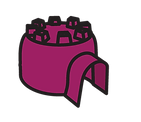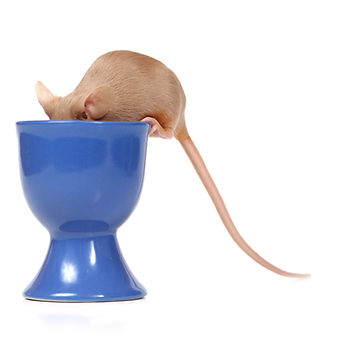MEET THE MOUSE

Mice have been cherished as pets for a very long time—since as far back as 1100 BC in China. It's easy to see why these small, clever rodents have such a long history with humans. They are remarkably intelligent and curious, capable of learning tricks and navigating mazes. Beyond their brains, pet mice are known for being clean, low-maintenance, and relatively easy to care for.
Lifespan

2 - 3 years
Good With Kids

Yes
Space Requirement

Small
Time Needed Outside Cage

Medium
Potty Trainability

Low
Diet Difficulty

Low
Care Difficulty

Low
Cleanliness

High
Human Interaction Needs

High
Cuddliness

Medium
ENCLOSURE REQUIREMENTS
MNPPR Recommends
DIY Ikea Deltof Habitat
Bin Cage Tutorial
Aquarium tanks of at least 20 gallons have enough room, but can be heavy. Some people choose to flip an IKEA Detolf cabinet on its side and build a custom lid, which provides double the required space and an excellent view of your mouse's living area. We recommend making a DIY tub/bin cage as they are appropriately sized, inexpensive, lightweight, and easy to clean. Store-bought cages such as Habitrails or similar are not recommended because even with the connecting tubes, they do not have enough floor space.
Minimum Dimensions
One to two mice:
30" L x 12" W x 12"H (or 2.5 cubic feet)



Other Notes
Mice prefer deep cages with at least 6 inches of bedding, tunnels, nesting materials, and climbing toys.
Cages should have plenty of ventilation, but be sure your mouse can’t escape through or chew on the holes. Any cage should have a solid floor since standing on wire can cause injuries and bumblefoot.
Inspect your mouse's cage every day for any signs of chewing.
Mice enjoy burrowing and building nests. Unscented soft recycled paper, shredded paper, and paper pellets are all great bedding options, either by themselves or mixed. MNPPR strongly recommends avoiding all wood-based beddings due to the general sensitivity of pocket pets.
ENRICHMENT REQUIREMENTS




Variety
toilet paper tubes
fiddlesticks
tunnels
bird toys
bits of fabric
ladders
cardboard
treat balls





Other Items
pet carrier
bedding: soft recycled paper such as CareFresh, shredded paper, or paper pellets

FEEDING REQUIREMENTS

Staple Diet
Always keep your mouse's food bowl full of high-quality rat/mouse kibble, pellets, or blocks such as Oxbow. Seed mix food should not be used. They are often missing vital nutrients, and many mice will only eat their favorite-tasting pieces, causing an unbalanced diet. If your mouse is overweight, they may need fewer treats or more exercise.
Treats
There are many options for store-bought treats made for mice, but fresh food can also make great treats. Be sure they are not storing anything in their nests that could rot. Mice should never get more than 1/4 tablespoon of treats a day, or they may become obese.
Safe Treats
apples
bananas
bell peppers
blueberries
broccoli
carrots
cauliflower
Cheerios
cranberries
cucumbers
cooked eggs
green beans
mealworms
parsley
peas
pumpkin seeds
plain popcorn
raspberries
sunflower seeds
timothy hay
unsalted crackers
yogurt
any citrus fruit
apple seeds
cabbage
cheese
corn
fizzy drinks
garlic
milk
onions
peanuts
poppy seeds
raisins
raw beans
raw meat
rhubarb
walnuts
Unsafe Treats
DISCLAIMER
All information shared by MN Pocket Pet Rescue is researched, up to date, and accurate to the best of our ability. We are not a licensed veterinary organization and do not intend to present ourselves as such. All educational material contains our best recommendations for care specific to each species. However, all animals are different, and some may have unique needs. MN Pocket Pet Rescue does not assume any liability for the well-being of any animal not under our care. Always use your best judgment and follow veterinary recommendations whenever necessary. If you have any questions or find inaccurate information, please contact us.



